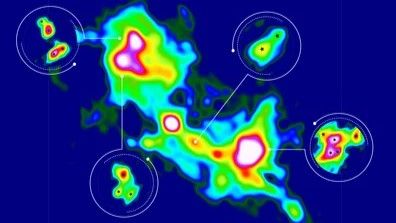Huge stars are born as twins, triplets and more, new images confirm
By Sharmila Kuthunur published about 13 hours ago
'Finally, we were able to take a detailed look at the rich array of multiple star systems in a massive star formation region!'

False-color image of the massive star formation region G333.23–0.06 from data obtained with the ALMA radio observatory. The insets show regions in which Li et al. were able to detect multiple systems of protostars. The star symbols indicate the location of each newly forming stars. The image covers a region 0.62 by 0.78 light-years in size (which on the sky covers a mere 7.5 times 9.5 arc seconds).
An image of the massive star formation region G333.23–0.06, generated from data obtained with the ALMA radio observatory. (Image credit: S. Li, MPIA / J. Neidel, MPIA Graphics Department / Data: ALMA Observatory)
A newly imaged crowded star cluster is birthing groups of three, four and five stars, confirming the prevailing wisdom that the universe forms its stars in multiples, astronomers reported last week.
Observations made with the Atacama Large Millimetre-submillimetre Array (ALMA) in Chile gathered between 2016 and 2019 of 30 large star-forming regions show that one protocluster, named G333.23-0.06, is birthing groups of multiple stars: four binaries, a triplet, a quadruple and one quintuple system. The findings, reported Jan. 15 in the journal Nature Astronomy, are consistent with what star formation models have long predicted, astronomers say.
"Finally, we were able to take a detailed look at the rich array of multiple star systems in a massive star formation region!" study co-author Henrik Beuther, of the Max Planck Institute for Astronomy (MPIA) in Germany, said in a statement.
"Particularly exciting is that the observations go as far as to provide evidence for a specific scenario for high-mass star formation," Beuther said.
Although models have long suggested multiple star births to be the norm, observational evidence has been hard to get, thanks to the dust-rich nature of stellar nurseries, which make imaging them difficult. Prior to the new ALMA results, observations had shown isolated multiple star systems within clusters, "but nothing like the teeming crowd of multiples predicted by the simulations," according to the MPIA statement.
More:
https://www.space.com/massive-stars-multiple-births-alma-images
